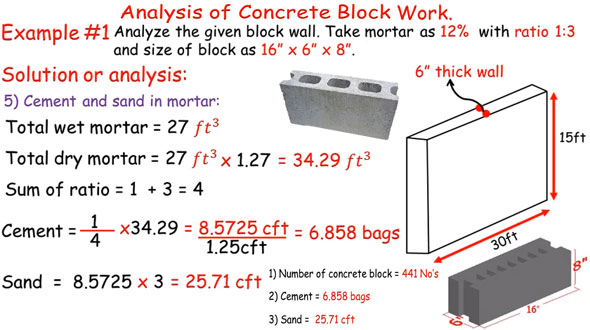How to analyze concrete block work perfectly
- Concrete Cost Estimator
- Concrete Continuous Footing
- Landscape Bidding and Estimating
- Construction Cost Estimating
- Concrete and steel cost estimation
- Construction Cost Estimate Breakdown
- Construction Estimating Worksheet
- Home Construction Cost Estimate
- Estimate Pricing Sheet
- Sheet for General Contractor
- Construction Cost Estimate
- Labor Materials Cost Estimator
- Masonry Estimating Sheet
- Sheet for Building Contractor
- Construction Schedule Bar chart
- General Cost Estimator Sheet
- General Construction Estimate
- Building and Road Estimating Sheet
- Detailed expense estimates
- Door and Window Takeoff Sheet
- General Construction Cost Estimating Sheet

In this construction video tutorial, some useful guidelines are provided to make analysis of concrete block work by applying the following steps :-
1) Determine the total Gross block work. ( in cu.m or in cu.ft )
2) Identify mortar. (here, mortar is taken as 12% of block work)
3) Identify total net block work.
Net block work = gross block work - mortar
4) Define number of blocks.
No’s of blocks = (net block work)/( volume of one block)
Note: For volume of a single block, no standard size of concrete block exist. It can be selected from specification. In this video, the dimension of block is taken as 16 x 6 x 8 inches.
5) Determine cement and sand for mortar mix.
In this video solution is given on the following problem :-
Prob: Analyze a block wall where mortar is 12% of block wall with proportion 1:3 and size of blocks is 16” x 6” x 8”.
The length of the block wall is taken as 15 ft and the height is taken as 30 ft. The density of the wall is 6”
Total block work is determined by multiplying length, thickness and height i.e. length x thickness x height
Total block work = 30 x 0.5 x 15 = 225 ft3
Total mortar = 12% of total block work i.e. 12%/100 x 225 = 27 ft3
Net block work = gross block work – mortar = 225 – 27 = 198 ft3
Numbers of blocks = Net block work/volume of one block
= 198/0.4489 ft3 (16” = 1.34 ft, 6” = 0.5 ft, 8” = 0.67 ft) = 441.0781911 = 441 numbers
Volume of cement and sand will be determined as follow :-
Total weight mortar = 27 ft3, it should be converted to dry mortar by multiplying it with 1.27
i.e. 27 ft3 x 1.27 = 34.29 ft3
We know, the proportion of cement and sand in mortar = 1:3 (cement : sand)
By summing up, we get = 1+3 = 4
The volume of cement = 1/4x34.29 = 8.5725 cft, to convert it to bags divide it with 1.25 (volume of one cement bag) i.e. 8.5725/1.25 = 6.858 bags or 7 bags approx.
The volume of sand = 8.5725 x 3 = 25.71 cft (as sand is 3 time of cement volume)
Video Source: SL Khan

- Application of concrete calculator
- Roofing Calculator can streamline the roof estimating process
- House construction cost calculator
- Engineering column design excel spreadsheet
- Material Estimating Sheet with Excel
- Materials List and Cost Estimate Worksheet
- Concrete Slab Estimating Calculator Sheet
- Common types of foundations for buildings
- Online calculation of construction materials
- Estimating with Excel for the Small Contractor
- Concrete Beam Design Spreadsheet
- Virtual Construction Management app for construction
- Autodesk’s Project Skyscraper
- Reed Construction’s Reed Insight
- Manage your construction project documentation
- Costimator, the popular cost estimating software
- On Center Software for construction professionals
- Free Construction Estimating Software
- Plumbing Calc Pro
- Cost Estimate Worksheet
- HVAC Piping Quantity Takeoff Worksheet
- Construction Estimating Software Sheet
- Estimate Cost Templates
- Construction Punch List
- Construction cost estimating template consisting estimating basic
- Gantt Chart Template for Excel
- Download Civil Engineering Spreadsheets with Verification
- The Building Advisor Estimating and Budgeting Worksheet
- Spreadsheet for design of concrete bridge
- Construction Estimating Software Free








